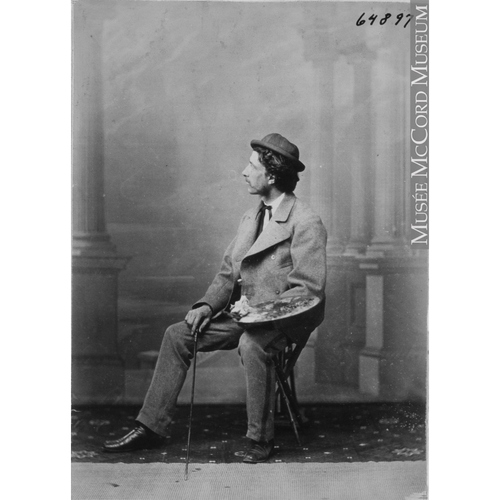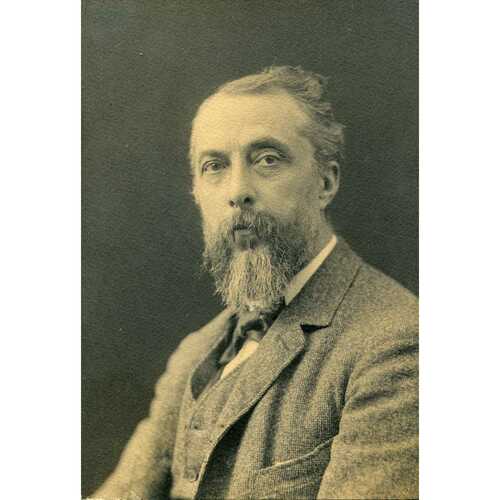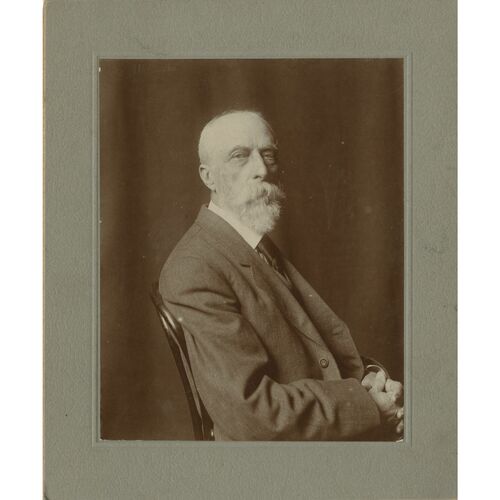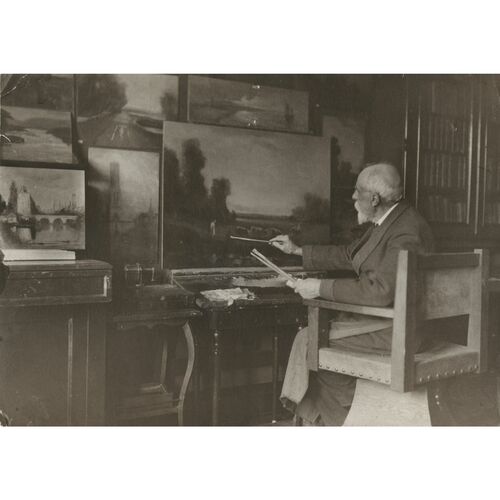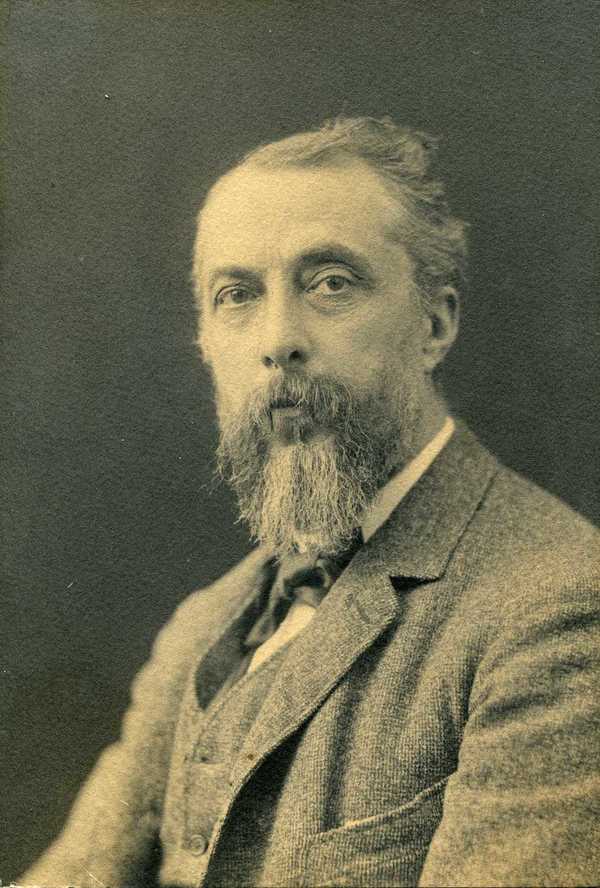
Source: Link
HAMMOND, JOHN, artist and educator; b. 11 April 1843 in Montreal, second son of Robert Hammond, a stonemason, and Elizabeth Burrell Young; m. first there 12 June 1872 Sarah Acres (d. 24 Jan. 1900); they had no children; m. secondly 19 June 1902 Katharine Jeanette Stark (d. 19 April 1942) in Arkville, N.Y., and they had a daughter; d. 10 Aug. 1939 in Sackville, N.B.
John Hammond’s parents immigrated to Lower Canada soon after their marriage in Southwark (London, England) in 1834. They settled in Montreal, where Robert eventually established a marble-cutting business. John may have assisted briefly at his father’s mill, but after attending Montreal Collegiate School between 1858 and 1860, he was apprenticed for six years with two dry-goods merchants – Ringland, Ewart and Company and Thomas Mussen. In June 1866 he and his younger brother, Henry, volunteered with the Victoria Rifles of Canada during the Fenian raids south of Montreal [see William Osborne Smith*].
Two months later John and Henry sailed to London to visit relatives. While there, they went to the National Gallery, and John recorded in his diary that they were “particularly taken with Turner’s paintings.” They then set out for New Zealand, where they hoped to take advantage of what promotional literature described, John later recalled, as “splendid opportunities for young men in the sheep growing districts.” Instead, having landed at Lyttelton on the South Island, they hiked to the goldfields on the west coast at Hokitika. After more than two years of arduous physical labour and plenty of adventure but no significant finds of gold in New Zealand or in Queensland, Australia, in the spring of 1868, they returned to Montreal for the wedding of their older brother, Robert, which was to take place in June the following year. Their southern travels had changed their lives in other ways, however. During the voyage to New Zealand, under the influence of a Mr Pole, a Baptist minister and fellow passenger, John and Henry had experienced a religious conversion. Both would later join the Plymouth Brethren.
During the 1860s photographer William Notman* and his family had rented a house owned by John’s father that was adjacent to the Hammonds’ residence on Rue Saint-Urbain. Notman would be an important early influence on the young man, who according to a later biographer had “made up his mind to be an artist” at the age of 11. Beginning in 1870, Notman’s Montreal studio employed Hammond to paint backgrounds and colour and retouch photographs. In 1871 Hammond accepted a six-month assignment as assistant to Benjamin Franklin Baltzly, photographer for the Geological Survey of Canada along a proposed route for the Pacific railway in British Columbia [see Alfred Richard Cecil Selwyn*]. After his recent experience in New Zealand, he was physically prepared for the difficult journey through forest and over mountainous terrain carrying cumbersome photographic equipment and assembling a botanical collection for the survey.
Hammond returned to Montreal in December, married his girlfriend of long standing, Sarah Acres, six months later, and continued to work full-time for Notman. Through the photographic studio he formed significant friendships with John Arthur Fraser*, Henry Sandham*, Wyatt Eaton*, and other painters. He soon applied for membership in the Ontario Society of Artists and began exhibiting his work. In 1877 he accompanied Fraser on a sketching trip to New Brunswick via the newly completed Intercolonial Railway.
By the following year Hammond had been transferred to Saint John as manager of a photographic studio originally run by Notman’s brother James. As an artist, Hammond was inspired by Saint John Harbour, which would become the focus of many of his best-known works. Influenced by Turner’s dark atmospheric effects, he used similar techniques in his depiction of marine subjects in both oil paintings and, between 1882 and 1886, intaglio prints. Hammond’s meticulous draftsmanship is evident in his sketchbooks and was well suited to the medium of etching, in which he was assisted by American artist Stephen Parrish. Likely through his position at the Notman studio, he met Robert Reed, a wealthy merchant who was establishing an art school in the city with funds from the estate of shipbuilder John Owens. In April 1884 Hammond left his position with the Notmans when he was hired as instructor and superintendent of the Owens Art Institution, installed in the converted Zion Church in Portland (Saint John). He was sent to Europe for 18 months in order to visit other schools and purchase works of art and plaster models for the new enterprise.
On the Continent Hammond renewed connections with friends such as Eaton, who probably introduced him to Jean-François Millet fils, William Blair Bruce*, Theodore Robinson, Louis Welden Hawkins, and other artists from whom he purchased paintings for the Owens collection. He also briefly attended the École Nationale des Beaux-Arts in Paris in 1884 to study portraiture and miniature painting. Two of his oils were accepted at the Paris Salon of 1885. This achievement was a pinnacle moment for the Canadian artist, who could now state for the rest of his career that he was an exhibitor at the prestigious event. He would appear at the Salon only once more, in 1887.
Hammond returned from Europe in late September 1885 and began teaching at the Owens Art Institution on 12 October. There were 20 students in attendance on the first day, and by the end of January enrolment had increased to 80. In 1890 he acquired another influential contact when he met railway builder William Cornelius Van Horne*, who employed him, as he had other artists such as Fraser, Lucius Richard O’Brien*, and William Brymner*, to paint along the route of the Canadian Pacific Railway in order to promote train travel across the country. Hammond spent several summers between 1891 and 1906 on these assignments. The CPR’s advancement of new steamship lines to Asia procured trips for him to China in 1900 and Japan the following year. Two of his commissions were large landscape murals for the CPR’s offices in New York and London, painted in 1904 and 1905.
He had become a full member of the Royal Canadian Academy of Arts in 1893 and exhibited several paintings at the World’s Columbian exposition in Chicago that year. He had also moved to Sackville to become professor of fine art at Mount Allison ladies’ college, after the Owens Art Institution closed in the spring of 1893 and its collection was transferred to the university. (A purpose-built gallery designed by Edmund Burke* would open in 1895.) Hammond would remain at Mount Allison for the rest of his life. A dedicated and respected teacher, he expanded the curriculum to include outdoor sketching, miniature painting, etching, art history, design, and applied arts such as wood carving and metal and leather work.
Hammond retained close ties to Montreal, where he kept a studio at the Art Association of Montreal for several years, and he frequently exhibited and sold his paintings at commercial galleries there and in Toronto and Ottawa. By 1901 he was earning nearly 40 per cent of his income outside his teaching salary. He also regularly showed his work at the major annual exhibitions in Canada and at many international venues, such as the Royal Academy of Arts in London in 1886, 1887, 1889, and 1890. He won a silver medal at the Pan-American exposition of 1901 in Buffalo, N.Y., and a bronze at the Louisiana Purchase exposition three years later in St Louis, Mo. His assistant teachers in Sackville were often left on their own for weeks at a time while he travelled abroad. Hammond was known for making copies of his most successful works, such as his 1885 Salon painting Étude, many of his European studies, and his depictions of Saint John Harbour. His work was popular, but his prolific output and frequently repeated imagery aroused some criticism during his lifetime.
John Hammond retired from teaching in 1916, at the age of 73, but he continued to advise students and to paint and exhibit at his campus studio. In 1930 he was awarded an honorary lld by Mount Allison College in acknowledgement of his important contributions to art education at the institution. Despite working in relative isolation in eastern Canada throughout much of his career, Hammond was recognized in national and international organizations and exhibitions. His success as an artist enhanced the reputation of the school at Mount Allison, and his awareness of international trends meant that he was quick to adapt the curriculum by adding, for example, outdoor sketching and drawing “from the draped model” in the studio in 1894. Though none of his students became major artists, several, including Greta Submit Ogden, Elizabeth Amelia McLeod, Christian McKiel, and Sara Hart, were influential teachers at the school and maintained the standard of excellence that he had established. It is an apt tribute to this artist and teacher that the Owens Art Gallery at Mount Allison, in whose early history he was a significant figure, holds the largest public collection of his work.
John Hammond’s portrait was painted by Robert Harris* (with whom he once shared a studio in Montreal), Edmond Dyonnet, and Hammond’s daughter, Katharine Elizabeth Hammond Krug. Photographs of the artist can be found in the Mount Allison University Arch., Sackville, N.B.; the McCord Museum, Notman Photographic Arch., Montreal; the AO; and the New Brunswick Museum, Arch. and Research Library, Saint John. In addition to the Owens Art Gallery in Sackville, Hammond’s work is held by the Art Gallery of Ont., Toronto; the Glenbow Museum, Calgary; the Montreal Museum of Fine Arts; the National Gallery of Can., Ottawa; and other public and private collections.
BANQ-CAM, CE601-S63, 6 Aug. 1843; CE601-S95, 12 June 1872. McCord Museum, Notman Photographic Arch., Notman’s wages book, 1870–78. Mount Allison Univ. Arch., 2004.12 (John Hammond fonds). Allisonia (Sackville), 1 (1903–4)–11 (1913–14). Andrew Birrell, Benjamin Baltzly: photographs & journal of an expedition through British Columbia, 1871 (Toronto, 1978). Roger Boulet, Vistas: artists on the Canadian Pacific Railway, with an essay by Terry Fenton (Calgary, 2009). E. P. Evans, “Lost art: an examination of the applied arts programme at Mount Allison University, 1854–1961” (ba thesis, Mount Allison Univ., 2002). John Hammond, 24 November 2002 to 12 January 2003 (exhibition catalogue, Owens Art Gallery, 2003). P. J. Larocque, “Fine intentions: an account of the Owens Art Institution in Saint John, New Brunswick, 1884–1893” (ma thesis, Univ. of N.B., Fredericton, 1996). E. de R. McMann, Montreal Museum of Fine Arts, formerly Art Association of Montreal: spring exhibitions, 1880–1970 (Toronto, 1988). J. A. Nesbitt, A short biography of Canada’s oldest artist, John Hammond, r.c.a. … (Montreal, 1929). J. G. Reid, Mount Allison University: a history, to 1963 (2v., Toronto, 1984). G. F. G. Stanley, “John Hammond: painter for the CPR,” in The CPR west: the iron road and the making of a nation, ed. H. A. Dempsey (Vancouver and Toronto, 1984), 208–27. R. L. Tovell, A new class of art: the artist’s print in Canadian art, 1877–1920 (Ottawa, 1996).
Cite This Article
Jane Tisdale, “HAMMOND, JOHN,” in Dictionary of Canadian Biography, vol. 16, University of Toronto/Université Laval, 2003–, accessed December 31, 2025, https://www.biographi.ca/en/bio/hammond_john_16E.html.
The citation above shows the format for footnotes and endnotes according to the Chicago manual of style (16th edition). Information to be used in other citation formats:
| Permalink: | https://www.biographi.ca/en/bio/hammond_john_16E.html |
| Author of Article: | Jane Tisdale |
| Title of Article: | HAMMOND, JOHN |
| Publication Name: | Dictionary of Canadian Biography, vol. 16 |
| Publisher: | University of Toronto/Université Laval |
| Year of publication: | 2019 |
| Year of revision: | 2019 |
| Access Date: | December 31, 2025 |


